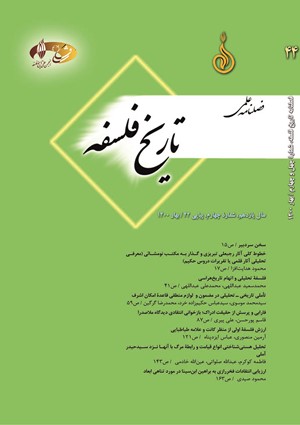تأملی تاریخی ـ تحلیلی در مضمون و لوازم منطقی قاعدة امکان اشرف
محورهای موضوعی : ریشهشناسی واژگان (اتیمولوژی) فلسفیسيدمحمد موسوي 1 , سید عباس حکیم زاده خرد 2 , محمد رضا گرگین 3
1 - دانشیار گروه فلسفه و کلام اسلامی دانشگاه علوم اسلامی رضوی، مشهد، ایران
2 - دانشجوی دکتری دانشگاه ایلام، ایلام، ایران
3 - دانشجوی دکتری دانشگاه شیراز، شیراز، ایران
کلید واژه: انوار مجردعلیتسنخیتامکان اشرفممکن اخس,
چکیده مقاله :
مطابق قاعدة امکان اشرف که نزد قاطبه فیلسوفان مسلمان پذیرفته شده، تقدم ممکن برتر بر ممکن فروتر در نظام ایجاد، ضروری است. با توجه به برخی قرائن تاریخ تحول اندیشة فلسفی در جهان اسلام، نخستین بار در حکمت اسلامی، شیخ اشراق به توضیح و اثبات این قاعده و توجه به ابعاد و لوازم آن پرداخته، هرچند رگههایی از محتوای این قاعده در سخنان ارسطو نیز یافت میشود. پس از سهروردی، حکمای دیگری همچون میرداماد و صدرالمتألهین در مکتب فلسفی اصفهان و علامه طباطبایی در دورة اخیر، برای اثبات این قاعده براهینی اقامه کرده و نتایج زیادی را بر آن مترتب دانستهاند. در جستار حاضر ابتدا براهین حکما بر اثبات این قاعده گزارش میشود و سپس به سیر تاریخی آن میپردازیم. نکته قابل اعتنا در این تحلیل آنست که هر چند مضمون اصلی قاعده از بیانی صحیح برخوردار است و بروشنی با موازین فلسفی مطابقت دارد، اما نمیتوان آن را قاعدهیی جدید در فلسفه بشمار آورد بلکه در حقیقت، بیانی مصداقی از اصل سنخیت میان علت و معلول است.
According to the principle of the possibility of the nobler, which is accepted by all Islamic philosophers, the priority of superior possible over lower possible in the system of making is necessary. Given the existing evidence in the history of the evolution of philosophical thought in the world of Islam, Suhrawardi was the first Islamic philosopher who explained and demonstrated this principle and paid attention to its dimensions and concomitants, although there are some traces of the content of this principle in Aristotle’s words. After Suhrawardī, some other philosophers such as Mīr Dāmād and Mullā Ṣadrā in the philosophical school of Isfahan and ‘Allamāh Ṭabāṭabā’ī in the contemporary period presented some arguments to prove this principle and referred to several of its consequences. Here, the authors initially report the philosophers’ arguments for demonstrating this principle and then discuss its historical development. The noteworthy point of this analysis is that, although the main content of this principle has been correctly phrased and clearly corresponds with other philosophical principles, it cannot be considered a new principle in philosophy. It is, rather, another form of the principle of the commensurability of the cause and effect.
ابنسینا (1375) الإشارات و التنبیهات، قم: نشر البلاغه.
ابنسینا (1379) النجاة، تهران: دانشگاه تهران.
ابنسینا (1404الف) التعلیقات، بیروت: مکتبة الاعلام الاسلامی.
ابنسینا (1404ب) الهیات شفا، قم: كتابخانه آیتالله مرعشی.
دشتکی، صدرالدین (1382) اشراق هیاکل النور لکشف ظلمات شواکل الغرور، تهران: میراث مکتوب.
دوانی، محمد بن اسعد (1411ق) ثلاث رسائل، تحقیق احمد تویسرکانی، مشهد: آستان قدس رضوی.
سبزورای، حاج ملاهادی (1369) شرح المنظومه، تحقيق حسنزاده آملی، تهران: نشر ناب.
سهروردی، شهابالدين (1372) مجموعه مصنفات شيخ اشراق، تصحيح هانري كربن، تهران: مؤسسه مطالعات و تحقيقات فرهنگي.
سهروردی، شهابالدين (1385) المشارع و المطارحات، ترجمه صدرالدين طاهری، تهران: كتابخانة مجلس شورای اسلامی.
شهرزوری، محمد بن محمود (1383) الشجرة الالهیّة، تصحیح نجفقلی حبیبی، تهران: مؤسسه پژوهشی حکمت و فلسفه ایران.
ملاصدرا (1380) الحكمة المتعالیة فی الاسفار الاربعة، ج7، تصحيح و تحقيق مقصود محمدی، تهران: بنیاد حکمت اسلامی صدرا.
فیاضی، غلامرضا؛ حیدرپور، احمد (1397) «تحلیل و ارزیابی قاعده امکان اشرف»، معرفت فلسفی، سال 16، شمارة 2.
میرداماد، محمدباقر (1374) قبسات، تهران: دانشگاه تهران.
میرداماد، محمدباقر (1376) تقویم الإیمان، تهران: ميراث مکتوب.
